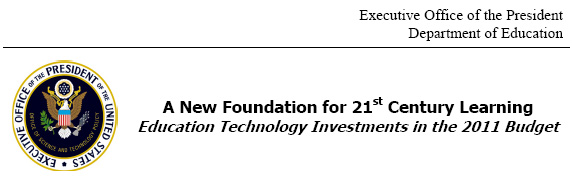 The 2011 Budget makes a strong commitment to technology that transforms how educators teach and how students learn. The President strongly believes that technology, when used creatively and effectively, can transform education and training in the same way that it has transformed the private sector. It makes a broad array of Department of Education programs, including the $500 million “Investing in Innovation” Fund, eligible for technology-related investments, encouraging the infusion of educational technology across a broad range of programs in order to improve teaching and learning, and build the capacity at the State and local level to support better uses of technology for efficient and effective transfer of knowledge.
The 2011 Budget makes a strong commitment to technology that transforms how educators teach and how students learn. The President strongly believes that technology, when used creatively and effectively, can transform education and training in the same way that it has transformed the private sector. It makes a broad array of Department of Education programs, including the $500 million “Investing in Innovation” Fund, eligible for technology-related investments, encouraging the infusion of educational technology across a broad range of programs in order to improve teaching and learning, and build the capacity at the State and local level to support better uses of technology for efficient and effective transfer of knowledge.
Potential for Transformative Impact:
Last year, the President released A Strategy for American Innovation, highlighting the role of technology in educating the next generation. The strategy outlined the role that educational technology could play to improve our quality of life and establish the foundation for the industries and jobs of the future. For example (emphasis below from DSC):
- Online learning can allow adults that are struggling to balance the competing demands of work and family to acquire new skills, and compete for higher wage jobs, at a time, place and pace that is convenient for them. It can also improve access to a quality education for students in underserved areas.
- Digital tutors can provide every student with immediate feedback and personalized instruction, providing them with the information needed to diagnose and correct errors, and providing challenging instruction.
- Digital learning environments can generate a large volume of data that, if analyzed properly, will support “continuous improvement” by providing rich feedback to learners, teachers, curriculum designers, and researchers in the field of learning science and technology.
- “Games for learning” that are compelling and engaging have the potential to increase the attentive time on task that students engage in learning. Massive multiplayer games can support the social and team-based dimensions of learning.
- Simulations, such as a flight simulator for pilots or a “digital human” for medical professionals can allow students to engage in hands-on learning.
- Open educational resources can be shared, adapted, re-mixed, and re-used.
- Technology can increase parental involvement, provide new opportunities for students with disabilities and for English Language Learners, allow teachers to participate in “communities of practice,” and enlist professionals and retirees as online mentors.








